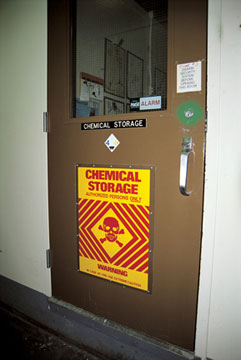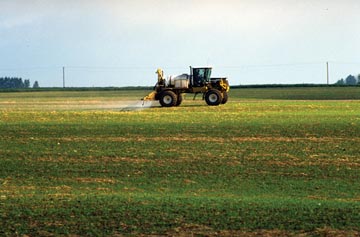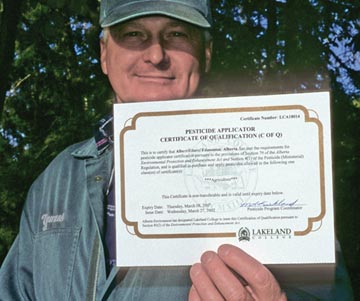| | Pesticide storage | Large and small scale pesticide handling and application | Cleaning and maintaining application equipment | Transporting pesticides | Custom applicators | Pesticide training | Legislation | For more information
Pesticides provide producers with effective means to control weeds and pests such as insects and rodents, as well as bacteria, fungi, parasites and pathogens. If not managed properly, pesticides can pose serious environmental and health safety risks. Understanding potential hazards associated with pesticides and properly storing, handling and applying them can minimize or even eliminate any potential risks that may exist on your farm.
Pesticide Storage
The best way to eliminate any environmental risk associated with pesticide storage is to avoid storing pesticides on the farmstead. If you cannot use the pesticide within a reasonable time, then make arrangements with your supplier for storage, or minimize the volumes you have by sharing the extra pesticide with your neighbours. When storing or transporting pesticides, the best practice is to keep the pesticide in the original container with all labelling clearly visible. Always ensure the container is transported with secondary containment to catch any spills or leaks.
If you must store pesticides, do so with the following guidelines in mind:
- Store minimal amounts of product. Storage time should not exceed the growing season.
- Use secondary containment made of an impermeable material to contain possible leaks. For example, store chemical jugs in tubs or trays on storage shelves.
- All original containers must retain manufacturers’ labels, and any secondary containers must also be properly labelled, detailing the contents and date.
- Consult the pesticide label for specific storage instructions.
- Do not store with or near food, feed, seed, drinking water, protective equipment or emergency response equipment.
- Store and handle pesticides at a distance greater than 30 m (98 ft) from a water body and 90 m (295 ft) from a water well.
- Return unopened or non-compromised product to the dealer for a refund.
- If a product container is leaking, overpack the container by packing it in a larger container with leak collection material (such as kitty litter) until it can be properly transferred to a good container.
- Dispose of opened leftover product as a hazardous waste. For more information, refer to Chapter 8.
Storage facilities
When storing pesticides, ensure the facility:
- Is secure with signs posted indicating the storage contents.
- Is constructed to minimize or eliminate potential soil and water contamination by having curbs and an impermeable floor to contain spills and leaks.
- Does not have a floor drain, unless there is a proper holding tank for drainage collection. If there is a tank, it should be monitored regularly, and the fluid disposed of in accordance with hazardous waste regulations.

Store chemicals in a secure facility with appropriate signage
Courtesy of ARD
Large and Small Scale Pesticide Handling and Application
Activities that may affect the environment in and around a farmstead could range from mixing and loading of field sprayers to applications in a livestock yard, garden or surrounding field.
Whether dealing with large or small amounts of pesticides, use the following guidelines to reduce contamination and toxicity risks:
- Identify the problem and determine if the use of a pesticide is the only option or if there are other mechanical or biological means of control.
- If the use of a pesticide is the only option, choose the least toxic, most appropriate chemical for your situation.
- Read and follow product label directions as outlined by the manufacturer for:
- proper mixing procedures
- recommended application methods, rates and timing
- application restrictions for weather conditions
- use restrictions for cropping, grazing or harvesting
- special safety precautions and equipment
- proper disposal procedures for leftover product
- Record chemical type, rates and methods used as well as weather conditions, growth stages of crop and pests and application purpose for future reference.
Mixing and loading locations
The best option is to mix and load pesticides near the application site to minimize the risk of water or soil contamination. Any mixing and loading areas must be more than 30 m (98 ft) from a surface water body and more than 90 m (295 ft) from a water well. If you are mixing pesticides at a regular site on your farmstead, make sure the site is designed to contain spills and leaks.
When loading pesticides, remember to:
- Never leave filling procedures unattended (someone over the age of 16 must be present at all times).
- Have spill containment and cleanup equipment ready, such as an absorbant material like kitty litter.
- Have a cell phone or two way-radio available (if possible) for emergencies.
- Prevent backflow from the sprayer to the water source:
- Never place a hose into the sprayer tank or container below the water line.
- Install backflow preventer devices on all water lines leading to the storage area and pad.
- Fit spray equipment with an operational backflow preventer.
Cleaning and Maintaining Application Equipment
To reduce or eliminate risks associated with equipment problems, plant damage or animal toxicity, it is important to clean and maintain all chemical application equipment. This practice ensures pesticide efficacy, as well as reduces risks associated with cracked hoses and leftover residue. Any chemical residues in spray containers or tanks can potentially contaminate other pesticides used in other applications.
When preparing for the next pesticide application:
- Inspect and perform regular maintenance checks on all equipment.
- Calibrate application equipment.
- Clean and rinse all parts of the application equipment thoroughly with water or other solution as advised by the product label.
- Designate sites to clean, flush and rinse the equipment.
- Dispose of the rinsate according to product label directions:
- If possible, apply rinsate directly to treatment area.
- If you cannot apply it on the treatment area, then:
- Apply it on land away from surface water, water wells, septic systems, gardens, shelterbelts and other environmentally sensitive areas.
- Use it as mix water for later applications when the same chemical is being applied.
- Apply it on areas requiring pesticide control.

Dispose of rinsate away from environmentally sensitive areas
Courtesy of ARD
Transporting Pesticides
The Transportation of Dangerous Goods Act applies when transporting pesticides on public roads. However, it is best to have your local vendor deliver pesticides to the place of use. If delivery is not an option, safely secure all pesticides before and during transportation. Never leave pesticides unsupervised in a vehicle, unless the chemicals are located in a place inaccessible to the public or in an enclosed compartment of the vehicle. Remember to never transport pesticides with food, feed, household furnishings, toiletries, clothes, bedding or similar items.
Custom Applicators
A beneficial management practice is to hire a custom applicator to reduce risks with pesticide application. Custom pesticide applicators have attended and passed a pesticide applicator course and may lawfully offer pesticide services to others. As a producer, you have the legal responsibility to ensure that any pesticide application performed on your property does not harm adjacent properties or people. By hiring a custom applicator and working with them to control pests and weeds on your farm, you are minimizing your environmental risk.
Pesticide Training
Voluntary pesticide training and certificate courses are available for Alberta producers. The training provides you with the knowledge to safely and effectively use pesticides, from understanding how they work (mode of action) to clean-up and disposal. Some pesticides require producers to obtain special certification before they purchase and use these products on their own property. By taking a pesticide application course, you also learn about the risks associated with pesticide use. Knowing and understanding these risks will help you eliminate or reduce any environmental risk when working with pesticides on your operation.
For more information on these courses, contact your local agricultural college.

Obtaining a Pesticide Applicator Certificate eliminates or minimizes environmental risks when working with pesticides
Courtesy of ARD
Legislation
Producers should be aware of the following pieces of legislation that pertain to pesticides and the environmental risks associated with their use. For more information on legislation, refer to Chapter 12 of this manual.
Federal Legislation
Fisheries Act
Pest Control Products Act
Transportation of Dangerous Goods Act
Provincial Legislation
Agricultural Pests Act
Environmental Protection and Enhancement Act
Weed Control Act
For More Information
All Alberta government offices may be reached toll-free by dialing the Rite Line: 310-0000
Alberta Agriculture and Forestry
Publications: 780-427-0391
Alberta Government Library: 780-427-2985
- Impacts of Farm Inputs (video loan)
Ag-Info Centre: 310-FARM (3276)
Alberta Environment
Publications: 780-427-2700
Disposal of Treated Seed
- Focus on Pesticides
- Guidelines for Mobile Pesticide Storage Facilities
- Pesticide Container Collection Program
- Pesticide Regulation Factsheets
- Pesticide Services
- Pesticide Storage: Regulatory Requirements and Guidelines
- Pesticide Waste Disposal for Commercial Pesticide Applicators, Services and Vendors
- Prevention of Water Contamination by Pesticides
Direct all pesticide complaints or reports of spills/releases to Alberta Environmental Response Centre at the 24-hour-toll free line: 1-800-222-6514.
Pesticide Management:
Alberta Transportation
Publications: 1-800-272-9600
- Dangerous Goods and the Agricultural Industry
Queen’s Printer
Phone: 780-427-4952
- Environmental Code of Practice for Pesticides
Pest Management Regulatory Agency
Publications: 1-800-267-6315
- Regulation of Pesticides in Canada
CropLife Canada
Publications: 416-622-9771
- Pesticide Safety Handbook
|
|